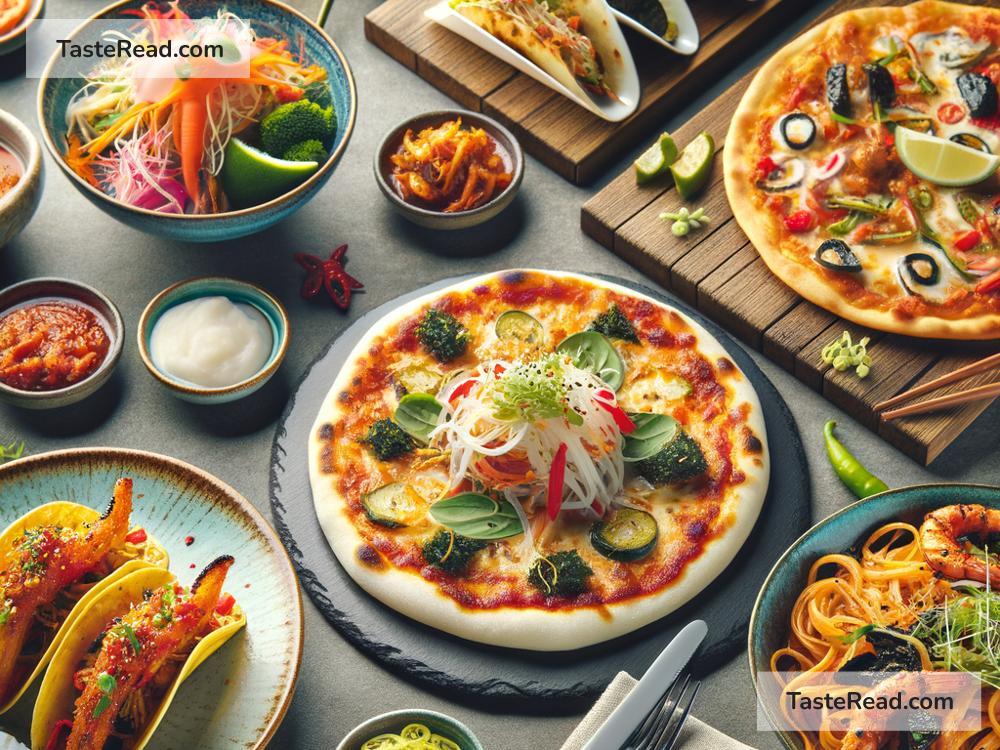The Emergence of Fusion Cuisine: A Delicious Global Trend
Food has always been an important part of human culture. It’s how we connect with people, celebrate life, and express creativity. Over the years, culinary trends have come and gone, but one trend that has remained popular is fusion cuisine. Fusion cuisine is the blending of flavors, techniques, and ingredients from different cultures to create something new and exciting. In simple terms, it’s when chefs combine ideas from different countries to make food that stands out. Let’s explore how fusion cuisine became popular, why people love it, and what makes it special.
What Is Fusion Cuisine?
Imagine taking Italian pizza and adding spicy Mexican chorizo and fresh Korean kimchi as toppings. Or consider a classic Japanese sushi roll that’s full of Cajun-style shrimp instead of traditional fish. These dishes are great examples of fusion cuisine—foods that mix ideas from different culinary traditions.
Fusion cuisine isn’t just about tossing random ingredients together. It’s about blending techniques, flavors, and cultural influences thoughtfully. It requires creativity, a deep understanding of food, and some trial and error to get the perfect balance.
How Did Fusion Cuisine Begin?
Fusion cuisine is not new. Humans have been mixing flavors for centuries. As early as the Silk Road trade routes, spices, foods, and cooking techniques from different regions were exchanged. For example, Asian spices made their way to Europe, changing the way Europeans cooked their food. Similarly, tomatoes from the Americas became a key part of Italian cuisine even though they originally came from halfway across the world.
The global spread of food accelerated with exploration, colonization, and migration. When people moved to new places, they brought their cooking styles and recipes with them. They started combining their traditions with local ingredients, and unique dishes were born. In this way, fusion cuisine naturally grew out of people’s efforts to adapt and innovate.
Fusion Cuisine in Modern Times
What makes fusion cuisine so popular today? It has a lot to do with globalization. The world is more connected than ever before—travel is easier, and cultures are constantly interacting. People can find groceries and ingredients from all over the world at their local markets. Social media and food television have also opened up new ways for chefs and food lovers to share ideas across borders.
In the 1980s and 1990s, fusion cuisine became more visible on restaurant menus, thanks to adventurous chefs. Famous cooks like Wolfgang Puck experimented with blending Western cooking techniques with Asian flavors, creating dishes that were exciting and fresh. Nowadays, you can find fusion cuisine everywhere—at fine dining restaurants, fast food chains, and even food trucks. Popular global dishes like Korean BBQ tacos, sushi burritos, and butter chicken pizza are all examples of fusion cuisine.
Why Do People Love Fusion Cuisine?
Fusion cuisine has an appeal like no other. Here are some reasons why people enjoy it:
-
Exciting Flavors: Fusion cuisine lets chefs create bold new flavors by combining ingredients that wouldn’t normally go together. It offers exciting tastes that are uncommon in traditional dishes.
-
Cultural Exploration: Many people don’t have the chance to travel the world, but fusion dishes give them a taste of other cultures right in their hometown.
-
Creativity: Fusion cuisine thrives on creativity, and adventurous eaters often appreciate the surprise factor in trying something new.
-
Inclusivity: Combining cooking styles lets people from different backgrounds connect over food that represents multiple cultural influences. Fusion cuisine can bring people together.
The Challenges of Fusion Cuisine
While fusion cuisine is exciting, it’s not without controversy. Some people worry that blending cuisines can diminish the importance of traditional cooking styles. Others believe combining cultural elements without understanding their significance can be disrespectful. For example, using a traditional recipe from another culture casually or for profit without acknowledging its roots may upset people.
Chefs must strike a careful balance. Successful fusion dishes honor the cultures they borrow from, ensuring that the final product still feels authentic. When done with care, fusion cuisine can evolve culinary traditions rather than dismiss them.
Fusion Cuisine at Home
Fusion cuisine isn’t just for chefs in fancy restaurants. You can try it at home! Here are some tips to get started:
-
Experiment Slowly: Start by adding one ingredient from a different cuisine to a favorite dish. For example, add Japanese miso to an American-style soup.
-
Learn About Cultures: Read about the cuisines you’re blending. Understanding their history can help you make respectful and delicious creations.
-
Have Fun: Fusion cuisine is all about experimenting, so don’t be afraid to try strange combinations. Mistakes can sometimes lead to great discoveries.
The Future of Fusion Cuisine
Fusion cuisine is here to stay. As global connections grow, boundaries between cuisines will continue to blur. The younger generation, raised with access to a world of flavors, seems especially eager to embrace fusion in their cooking and dining experiences.
The future of fusion cuisine isn’t just about blending traditional foods—it’s also about exploring new sustainable ingredients, innovative techniques, and creating food that reflects our increasingly interconnected world. Who knows what mouthwatering creations are coming next?
Conclusion
Fusion cuisine is proof that creativity, curiosity, and culture can lead to delicious discoveries. By blending ideas from different parts of the world, chefs have created dishes that surprise and delight us. Whether it’s a simple homemade meal or a grand culinary experience, fusion cuisine invites us to taste the world in exciting new ways. So next time you’re at a restaurant or cooking at home, don’t be afraid to try something unexpected—you never know where the next great flavor will come from!


